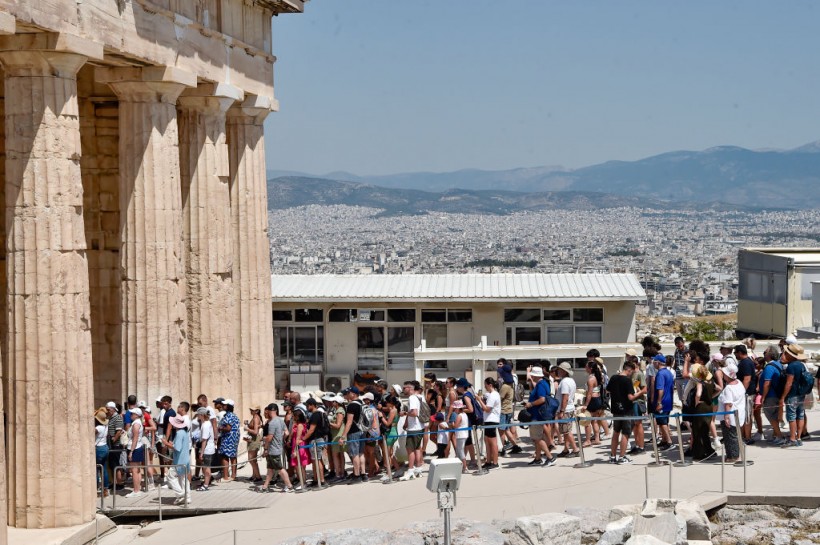
The ancient citadel Acropolis will limit its visitors to 20,000 daily maximum.
The old fortress Acropolis is suffering from tourism, therefore daily visitors are now limited to 20,000. This new restriction might protect the UNESCO World Heritage Site from potential harm caused by visitors.
Tourism for Greece's Ancient Citadel Acropolis
To ensure the security and long-term viability of the historic landmark, Greece has decided that it will restrict the number of daily visits to the Acropolis.
According to the nation's cultural minister, Lina Mendoni, the UNESCO World Heritage site in Athens would only allow 20,000 visitors each day beginning in September.
Mendoni stated that the move is being implemented as a trial after research by the government's Hellenic Organization of Cultural Resources Development.
According to her, the site presently welcomes approximately 23,000 visitors every day, and she considers this to be a significant number.
Mendoni continued to express that although tourism undoubtedly brings advantages to the country and its inhabitants, it is crucial to find ways to prevent any detrimental impact on the monument caused by excessive tourism.
The ancient citadel, built on a rocky hill in the 5th century BC, houses numerous historic ruins, structures, and artifacts, among which the renowned Parthenon temple dedicated to the goddess Athena holds the utmost prominence.
Designated UNESCO World Heritage Site vs. Overtourism
According to UNESCO, the Acropolis, and its monuments make up the world's largest architectural, as well as artistic complex from Greek antiquity.
The website is accessible every day from 8 AM to 8 PM, although according to Mendoni, half of the visitors typically arrive between 8 AM and midday.
According to Mendoni, this arrangement produces uncomfortable conditions for the location, the guests, and the employees who are attempting to handle this large number of people.
To prevent delays, Mendoni stated that the administration intends to establish hourly visiting limitations.
She stated, for instance, that from 8 to 9 AM, 3,000 persons will be allowed entry, followed by 2,000 from 9 to 10 AM.
The number restriction will change throughout the course of the day but will remain in effect from the moment the site opens until it closes.
Mendoni claimed that by taking this action, the government will be able to safeguard the monument and improve the entire experience for tourists.
She added that starting in early September, the new system will be tested; according to state broadcaster ERT, this trial will start on Monday, September 4.
Furthermore, Mendoni said that the limits will then be put into effect on April 1 in time for the summer of 2024, CNN reports.
Also Read: 'Swift Quake' Registers Magnitude 2.3 Seismic Activity During Seattle Leg of Concert Tour
Similar Situation
Fort Jesus, Lamu Old Town, and Stone Town of Zanzibar have been recognized by UNESCO and granted the status of World Heritage Sites.
Additionally, Old Town Mombasa has been designated as a buffer zone to support and safeguard the surrounding heritage sites.
Mombasa, on the other hand, primarily functions as a stopover location along the Swahili Coast, unlike Lamu and Stone Town. Locals are dissatisfied since expectations of a rise in tourism after Fort Jesus' designation were not met.
The circumstance exemplifies a recurrent criticism of the World Heritage List maintained by UNESCO.
Being listed might, on the one hand, lead to hopes of economic transformation, however, the reality is frequently different because of the lack of adequate financial support.
Mombasa locals feel limited by UNESCO restrictions and are unable to make the necessary adjustments because of a lack of funding.
According to experts, being included on the list may result in either over-tourism or, in some cases, under-tourism.
Overtourism can put a strain on the infrastructure and resources of the area, and under-tourism may be the result of the UNESCO designation not having a significant positive impact on the neighborhood.
This problem, which some refer to as "UNESCOcide," occurs when preservation efforts unintentionally destroy the very locations they intend to safeguard.
It has been seen in other UNESCO-listed sites around the world, The New York Times reported.
Related Article: Yosemite Rock Towers Disruptive to Wildlife, Rangers Allow Takedowns by Hikers
© 2024 NatureWorldNews.com All rights reserved. Do not reproduce without permission.
![Tsunami Hazard Zones: New US Map Shows Places at Risk of Flooding and Tsunamis Amid Rising Sea Levels [NOAA]](https://1471793142.rsc.cdn77.org/data/thumbs/full/70325/280/157/50/40/tsunami-hazard-zones-new-us-map-shows-places-at-risk-of-flooding-and-tsunamis-amid-rising-sea-levels-noaa.jpg)




